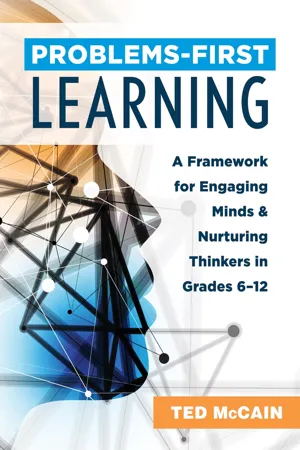
- 176 pages
- English
- ePUB (mobile friendly)
- Available on iOS & Android
Problems-First Learning
About This Book
The educational pattern of lecture, listen, and forget is deeply ingrained in schools. In this user-friendly resource, author Ted McCain offers a compelling alternative that flips lessons on their heads: the problems-first instructional method. Using this method, you will fully engage students by first introducing a problem and then empowering learners to solve it using creativity, innovation, collaboration, and other essential skills.
Use this resource to help students achieve higher levels of thinking:
- Identify the need for instructional change in the current educational system.
- Consider the transferable skills students need for solving problems in the workplace and in life outside the classroom.
- Study the benefits of a problems-first teaching style.
- Learn to implement problems-first methods into existing classrooms.
- Understand how this method teaches seven essential 21st century skills highly desired in the modern workforce.
- Discover how to introduce role-play into the classroom and broaden lessons to encompass whole-mind learning and boost student engagement.
Contents:
Acknowledgments
Table of Contents
About the Author
Introduction
Part One: Understanding New Needs and a New Approach for a Digital Generation
Chapter 1: The New Needs of a Changing Generation
Chapter 2: The Thinking and Processing Skills Students Need for the Future
Chapter 3: The Key to a New Approach
Part Two: Learning How to Create Problems-First Projects
Chapter 4: Envision a New Role for the Teacher
Chapter 5: Ensure That Problems Are First, Teaching Is Second
Chapter 6: Establish a Real-World Link Using Role-Play
Chapter 7: Expand Your View of the Curriculum
Chapter 8: Equip Students With the 4 Ds of Problem Solving
Chapter 9: Elevate the Students' Level of Thought
Chapter 10: Educate the Whole Mind
Chapter 11: Evaluate Holistically
Chapter 12: Ease Yourself Out of the Picture
Part Three: Making the Shift to Problems-First Teaching
Chapter 13: Pointers for Shifting to a Problems-First Approach
Chapter 14: Examples of Problems-First Lesson Plans
References and Resources
Index
Frequently asked questions
Information
Table of contents
- Cover
- Title Page
- Copyright
- Dedication
- Acknowledgments
- Table of Contents
- About the Author
- Foreword
- Introduction
- Part One: Understanding New Needs and a New Approach for a Digital Generation
- Part Two: Learning How to Create Problems-First Projects
- Part Three: Making the Shift to Problems-First Teaching
- References and Resources
- Index